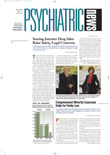A new research report confirms earlier data suggesting that bipolar I disorder exists as three distinct subgroups, defined by age at onset.
The course and presentation of bipolar I disorder—marked by at least one manic or mixed episode often accompanied by one or more major depressive episodes—have often been described as variable, in terms of both symptoms and response to treatment. Researchers have postulated the existence of an early-onset bipolar disorder that may be associated with a greater familial risk of affective disorders, including bipolar disorder; higher rates of comorbid conditions such as psychotic symptoms, panic disorder, conduct disorder, and substance abuse; and a poor response to treatment, usually including lithium resistance.
In addition, suicidal behaviors are thought to be more closely linked to early-onset than late-onset bipolar disorder. Several researchers have also reported preliminary evidence attempting to associate early- or late-onset forms of bipolar disorder with specific genetic risk factors. All of these associations appear to result in a poor prognosis.
Despite the increasing amount of data published on this topic in the last decade, researchers still have not established a firm threshold for age at onset that can be used in clinical, biological, or familial studies.
The latest report, from Frank Bellivier, M.D., Ph.D., a professor of psychiatry at the Henri Mondor Hospital in Cedex, France, appeared in the May American Journal of Psychiatry.
Bellivier and his colleagues presented data on 368 patients with bipolar I disorder, followed prospectively upon admission to three centers (one each in France, Switzerland, and Germany) from 1994 to 2001. In addition, the researchers recruited 130 patients with bipolar I disorder belonging to 59 sibling pairs from treatment centers in Ireland, Germany, and France from 1992 to 1997.
The same research team reported preliminary data in the May 2001 Archives of General Psychiatry on 211 patients with bipolar I disorder in which they postulated three subgroups for the disorder, characterized by age at onset. In that preliminary report they defined the three groups as having mean ages of onset of 16.9 years (41.4 percent of the 211 patients), 26.9 years (41.9 percent), and 46.2 years (16.6 percent).
For the 368 patients reported in the current study, the researchers again found a distribution grouped around three mean ages that was not statistically different from the ages in the 2001 report. The age of onset of the current group of patients were clustered around 17.6 years (21.4 percent of the 368 patients), 24.6 years (57.3 percent), and 39.2 years (21.2 percent).
The French researchers pooled two independent populations and calculated a best-fitting distribution model of 17.4, 25.1, and 40.4 years.
When the 59 sibling pairs were analyzed to compare age at onset between siblings, the researchers found that affected siblings were highly likely to belong to the same age-at-onset group.
They then grouped all affected families and assigned each to the age-at-onset group to which it had the highest probability of belonging. Twenty-eight of the 59 families (47.5 percent) belonged to the early-onset group, 29 families fit into the intermediate-onset group (49.2 percent), and two families (3.4 percent) were classified in the late-onset group.
The investigators believe that all three independent populations—the original 2001 study of 211 patients, the current report of 368 patients, and the concurrent 59 sibling pairs—provide supporting evidence for their three-subgroup model, defined by age at onset.
“This strongly suggests the existence of three genuine age-at-onset subgroups for patients with bipolar affective disorder,” they concluded. They added that further study is needed to confirm the model and to determine whether the use of age-at-onset subgroups could help to identify distinct genetic subgroups that revolve around age-specific genetic risk factors that contribute to the onset of the disorder.
American Journal of Psychiatry 2003 160 999
